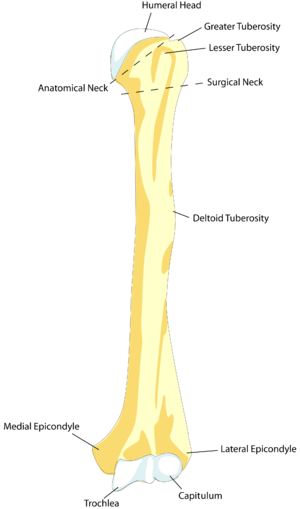We need you! Join our contributor community and become a WikEM editor through our open and transparent promotion process.
Fractures (main)
From WikEM
(Redirected from Fracture)
Contents
Describing Fractures[1]
A systematic approach for the description of fractures should be used to aid in clear communication with radiologists and consulting specialists.
- Laterality
- Open vs. Closed
- Affected Bone
- Location
- Intra-articular vs. extra-articular
- Portion of long-bone (proximal, middle, distal)
- Anatomic site (ex. supracondylar, intertrochanteric, subtrochanteric, femoral neck)
- Direction (orientation of fracture line relative to long-axis)
- Transverse
- Oblique
- Spiral
- Impacted
- Torus / Greenstick (Peds)
- Alignment
- Displacement (distal relative to proximal fragment)
- State in terms of direct measurement (e.g. 4mm) or %width of bones (50% displacement)
- Angulation
- Deviation from longitudinal axis, described in degrees and direction
- Direction of apex of angle formed from redrawn longitudinal axes of fracture fragments
- Rotation
- Twisting around longitudinal axis (distal relative to proximal fragment)
- Described as medial or lateral rotation (towards or away from midline respectively)
- Separation
- Distance two fragments have been pulled apart (but not offset from each other)
- Shortening
- Amount by which a bone's length has been reduced (expressed in mm or cm)
- May occur by impaction or by overriding
- Other
- Incomplete: Only one side of cortex disrupted
- Stress: Caused by repetitive low-force trauma/impact
- Pathologic: Caused by trivial trauma or biomechanically routine force, suggestive of abnormal bone.
- Fracture-Dislocation: Be careful not to describe these injuries as fractures with displacement
- Displacement (distal relative to proximal fragment)
- Fragmentation
- Segmental (>2 fragments, with one segment not connected to either end)
- Comminuted (>3 fragments)
Head and Neck
Maxillofacial Trauma
- Le Fort fractures
- Skull fracture (peds)
- Auricular hematoma
- Nasal fracture
- Zygomatic arch fracture
- Zygomaticomaxillary (tripod) fracture
- Dental trauma
- Mandible fracture
Orbital trauma
Acute
- Ruptured Globe^
- Corneal Abrasion
- Ocular foreign body
- Conjunctival laceration
- Caustic Keratoconjunctivitis^^
- Subconjunctival hemorrhage
- Traumatic iritis
- Traumatic hyphema
- Retinal detachment
- Retrobulbar hemorrhage/hematoma
- Traumatic mydriasis
- Orbital fracture
- Frontal sinus fracture
- Naso-ethmoid fracture
- Inferior orbial wall fracture
- Medial orbital wall fracture
Subacute/Delayed
Cervical Spine Fractures and Dislocations
Upper Extremity
Humerus Fractures
Elbow
- Adult
- Pediatric
Forearm Fractures
- Distal radius fractures
- Radia ulna fracture
- Isolated radius fracture (proximal)
- Isolated ulna fracture (i.e. nightstick)
- Monteggia fracture-dislocation
- Galeazzi fracture-dislocation
- Forearm fracture (peds)
Carpal fractures
- Scaphoid fracture
- Triquetrum fracture
- Lunate fracture
- Trapezium fracture
- Pisiform fracture
- Hamate fracture
- Capitate fracture
- Trapezoid fracture
Hand and Finger Fractures
Torso
Chest
Abdomen
Spine
Lower Extremity
Proximal Leg
Distal Leg Fractures
- Tibial plateau fracture
- Tibial shaft fracture
- Pilon fracture
- Maisonneuve fracture
- Tibia fracture (peds)
- Ankle fracture
- Foot and toe fractures
Foot and Toe Fractures
Hindfoot
Midfoot
Forefoot
Other
See Also
- Fracture management overview
- Splinting
- Diagnoses by Body Part (Main)
- Fractures and dislocations (peds)
- Open fracture
- Joint dislocations (main)
References
- ↑ Wolfson, A. B., Cloutier, R. L., Hendey, G. W., Ling, L., & Schaider, J. (n.d.). Approach to Musculoskeletal Injuries. In Harwood-Nuss' clinical practice of emergency medicine (6th ed.). LWW.


